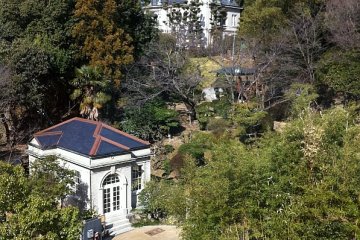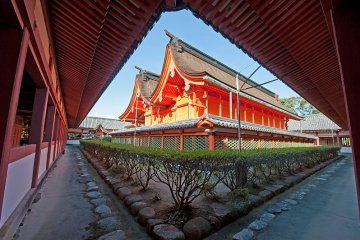

Most might not expect to find a French-style villa below Matsuyama Castle, but this elegant construction offers a respite from the bustling town center of Ehime. Bansuiso, largely hidden by trees and modern buildings, was originally the second Residence of Count Hisamatsu Sadakoto, a descendant of the Matsuyama samurai clan and former lord of the neighboring castle.
After living in France and returning with his love of Neo-Renaissance architecture, he commissioned the construction of the villa. Completed in 1922, it was the scene of numerous elite parties and social gatherings, and even welcomed members of the imperial family as guests, including Showa Emperor Hirohito.
Bansuiso serves as both a place of art and culture and a sight. The first floor and the basement are freely accessible and for ¥ 300 visitors can climb a wooden staircase to take advantage of more photo opportunities. Although the villa hosts solo exhibitions, it also has its own murals and portraits, including the portrait of the first owner.
5 minutes on foot from Okaido Station.

Matsuyama adalah ibukota perfektur Ehime dan merupakan kota terbesar di Shikoku. Memiliki arti nama “gunung pinus”. Matsuyama merupakan kota sibuk yang mempertahankan semangat gairah hidup meskipun dibayangi resesi panjang seperti kota-kota lain di Jepang. Matsuyama merasakan manfaat keberhasilan pimpinan dua walikota muda yang keduanya menaruh perhatian besar pada pariwisata. Kota memiliki bar dan restoran, menawarkan pilihan makanan dari seluruh dunia, sebagai tambahan makanan khas lokal seperti babi hutan dan ikan air tawar. Matsuyama merupakan rumah dari Dogo Onsen, rumah mandi mata air panas tertua di Jepang. Dogo Onsen masuk dalam artikel Michelin Green Guide, dan menjadi inspirasi dari animasi besar yang sangat populer Spirited Away. Pemandangan favorit lain adalah Kastil Matsuyama yang terletak di atas sebuah bukit tepat di tengah kota dan memiliki arti penting. Kuil ke delapan dari delapan puluh delapan kuil ziarah Shikoku berlokasi di Matsuyama, dan peziarah yang berjalan menuju kuil menjadi pemandangan biasa. Kuil Buddha yang terkenal dan indah di Matsuyama termasuk Ishite-ji, Taisan-ji, dan Jodo-ji, semuanya berasal dari abad ke delapan. Ishite-ji merupakan tempat yang aneh, termasuk dari serangkaian terowongan yang menakjubkan dengan bukit sebagai latar belakangnya. Kuil terkenal dari kota ini termasuk Isaniwa Jinja dan Tsubaki Jinja. Pada abad pertengahan, Matsuyama merupakan bagian dari Iyo-Matsuyama Domain, tanah perkebunan sebagai bagian dari pelayanan masa feodal provinsi Iyo termasuk didalamnya kota kastil, dengan desa Dogo Onsen hingga ke arah timur dan pelabuhan di arah barat dari Mitsuhama yang menghubungkan wilayah daratan Jepang dan Kyushu. Penyair haiku Masaoka Shiki tinggal di Matsuyama. Rumah beliau, sekarang disebut sebagai Shiki-do, dan sebuah museum, Shiki Memorial Museum, menjadi atraksi menarik, dan menjadi alasan utama kota yang memiliki peran dalam pergerakan haiku internasional. Novel Botchan yang dikarang oleh Natsume Soseki juga berlatar belakang Matsuyama. Terlepas dari kenyataan bahwa Soseki mengolok-olok dialeknya, apapun yang berada di kota ini disebut dengan Botchan ini dan Botchan itu. Matsuyama juga muncul dalam beberapa karya Shiba Ryotaro, terutama pada novel tahun 1969, Saka no Ue no Kumo (Awan di Atas Bukit). Hal inilah yang menjadi fokus utama dari penciptaan merek di bawah kepemimpinan walikota sebelumnya, yang menghasilkan drama panjang NHK yang diadaptasi dari novel tersebut, dan museum yang didisain oleh arsitek ternama Tadao Ando. Situs bersejarah lainnya yang layak untuk dilihat adalah Museum Itami Juzo yang didedikasikan kepada pengarah film terkenal. Secara fisik, Matsuyama merupakan kota yang cukup terpadu. Pusat kota dilayani oleh sistem trem dengan trem indah dari tahun 50-an dan 60-an, begitu juga dengan replika kereta uap yang indah, Botchan Ressha. Kota dikelilingi dengan pegunungan dan penggabungan sejumlah bukit, membuatnya terlihat hijau, dan memiliki perasaan berada di pedesaan. Tidak jauh dari jangkauan kota terdapat beberapa pantai berpasir menghadap air laut dalam Seto yang tembus cahaya. Kota juga memiliki beberapa gedung tua yang telah ada sejak periode Meiji bahkan periode sebelumnya. Terdapat beberapa gedung bergaya yang dibuat oleh arsitek Shiciro Giko, termasuk Vila Bansuiso yang penuh warna. Bandara Matsuyama memiliki penerbangan reguler menuju Tokyo, Osaka, dan kota-kota besar di Jepang lainnya, termasuk juga beberapa tujuan pilihan Asia termasuk Shanghai dan Seoul. Terdapat feri reguler menuju Hiroshima, termasuk feri ekspres yang hanya membutuhkan waktu satu jam. Feri malam menuju Kobe, Kokura, dan Kitakyushu.

Spa Ryokan Dougoya menawarkan pengalaman bergaya ryokan dalam bangunan 1930an di Dogo untuk budget traveler.

Menyediakan ramen tonkotsu yang ditaburi irisan daging menggunung.

Matsuyama dan Ehime menawarkan berbagai sajian kuliner yang mencerminkan keragaman geografis wilayah tersebut. Saran terbaik adalah... coba semuanya!

Ramen mewah di Matsuyama dengan saus kedelai dan suasana yang menyenangkan.

Matsuyama Castle is one of the twelve "original castles" in Japan, i.e. castles that have survived the post-feudal era since 1868 unscathed. It is located on the 132 meter high Katsuyama Mountain, which offers visitors a great view of Matsuyama and the Seto Inland Sea. With around 200 cherry trees on the castle grounds, Matsuyama Castle is a popular destination, especially when the cherry blossoms are in bloom. The castle was built between 1602 and 1628 and assigned to a branch of the Matsudaira family in 1635. It is an excellent example of a feudal castle. The Honmaru is located on the top of the hill and is accessible through several well-defended gates. The main tower is one of the few in the country that has multiple wings. The complex also includes a secondary keep and several towers. Inside the castle, some exhibits provide information about the history of Matsuyama and the feudal era.

The Botchan Railway Museum is designed as a museum for everyone. It tells the story of the Iyotetsu Railway, which has been available to the citizens of Matsuyama since it was founded in 1887. The exhibitions are entertaining even if you are not a huge railway fan yourself. A replica of the Iyotetsu No. 1 locomotive gives an insight into the scenery from the Meiji period. However, there are also individual railway sections and tracks from every era, a diorama of the old cityscape of Matsuyama and a selection of historical photos, so that the visitor can feel like on a journey through time.

Thought to be at least 1,000 years old, Isaniwa is one of Japan’s three shrines dedicated to the deity Hachiman. After climbing a long stretch of stone stairs, passing a double-story gate, a magnificent bright-red structure emerges. The architectural details are especially grand with the building’s swooping tile roofs, gold-leaf columns and ornate, cloudlike beam engravings. In addition to the spectacular architecture, there are displayed paintings of warriors and warfare (as Hachiman is the guardian of warriors and protector of Japan) and even numerous documents on Japanese mathematics. A hall of treasures features swords and armor for samurai history buffs. Other relics include animal paintings and calligraphy. Supposedly, Isaniwa Shrine originally marked the location where Emperor Chuai and Empress Jingu, who reigned in the third century AD, bathed at one of Japan’s oldest bathhouses, Dogo Onsen, now just a few hundred meters away. The shrine was moved to by the Kono samurai clan in the fourteenth century to the current location where, after conquering the stairs, you can enjoy breathtaking views of Matsuyama city. It was rebuilt in the 17th century by the Matsudaira clan; the current buildings with their great vermilion surface date from 1667. The original imperial bathers are enshrined there. Despite its age, the shrine is still buzzing with worshippers and even couples celebrating or taking pictures for their wedding. Although visitors note that the stairs are a little treacherous, the views and tranquil atmosphere only add to the experience of walking around the colonnade and absorbing a rich and long history—and if you’re lucky, observing a modern-day ceremony. If the trip does tire you out, you can always relax at Dogo Onsen at the foot of the compound.